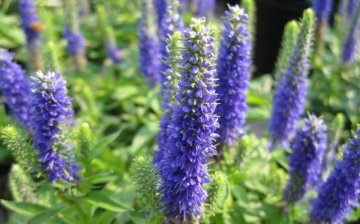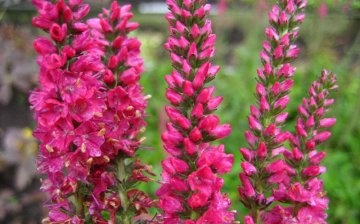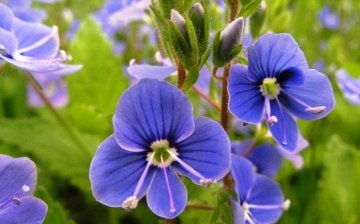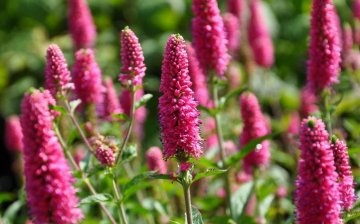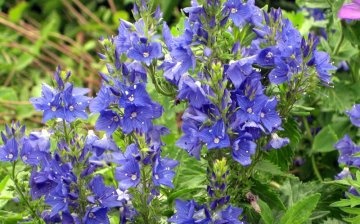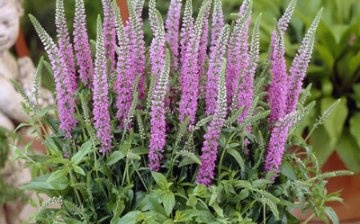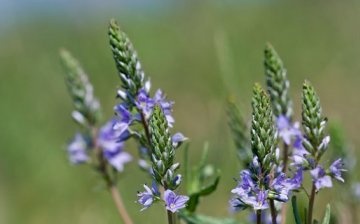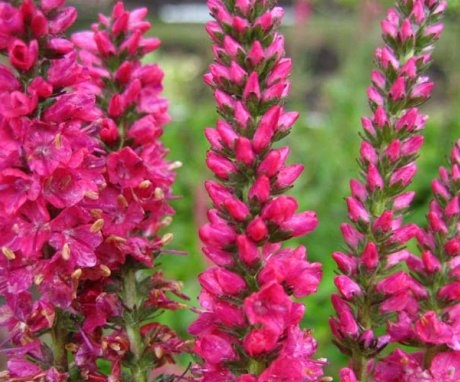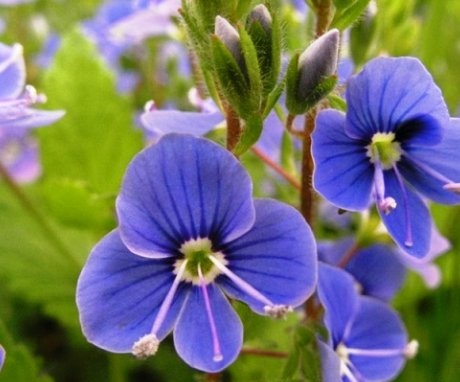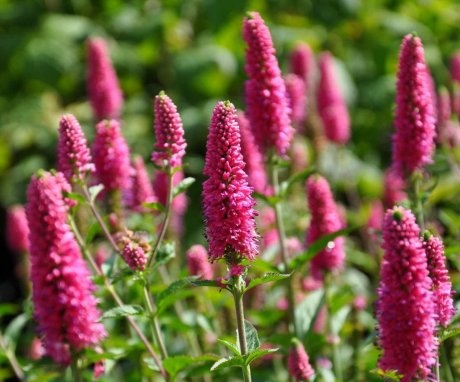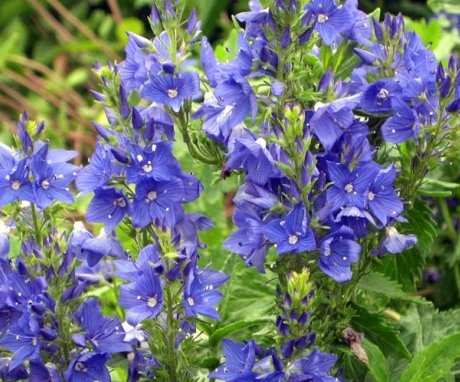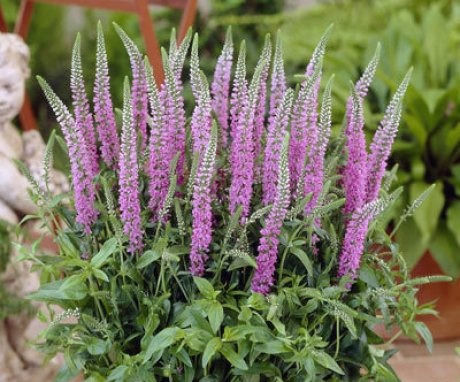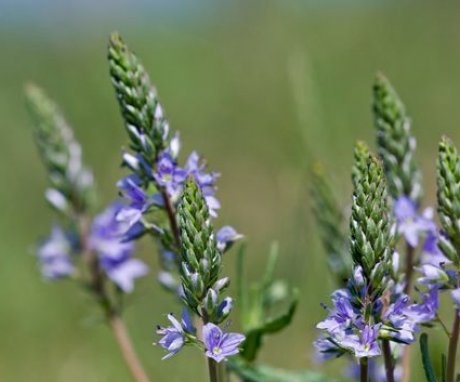Veronica: types, cultivation and medicinal properties of the plant
Veronica - the plant is beautiful and useful. It was first used in medicine. Then they paid attention to delicate and delicate flowers. Flower breeders have created many original varieties of this plant, which differ in the size and color of leaves and flowers.
Content
- Veronica: plant description
- Types of Veronica
- Growing and care
- Reproduction of Veronica
- Veronica's application
- The medicinal properties of the plant
Veronica: plant description
Veronica belongs to the Plantain family. Although earlier she was referred to as the Veronikovs. It contains from 300 to 500 species, therefore it is the largest genus in the family. Veronica is a ground cover plant. It is used as a companion, planting next to bright and catchy flowers. Veronica grows on all continents, including the Arctic. It is especially common in areas with cool climates.
The plant has several popular names: snake, cyanosis, andreev's grass.
There are annuals, perennials and dwarf shrubs with lignified whips. These are plants with narrow, mostly whole leaves, pubescent (ciliate Veronica) or smooth. Near the inflorescences, the stem is often covered with glandular hairs. Cuttings of leaves can reach 13 cm (Veronica long-leaved), and can be very short, from 1 mm. In Veronica the telefielist, they are enlarged. The key does not have them at all. The color of the leaves is green or gray (in pubescent species). Flowers are small, delicate. They are collected in inflorescences of a spike (spicate, gray-haired), an umbrella or a panicle. Each of the flowers has petals with a pointed edge and dark veins and two stamens. Pedicels of different lengths.
Veronica rhizomes are thin in species growing on fertile soils, or branched and shortened if the plant habitats are mountainous stony areas. Mountain Veronica species can grow with a minimum amount of soil, between stones. Stems are erect and creeping. Veronica doesn't ask for much leaving... Well tolerates trampling. After walking around the site, the leaves and stems will soon rise.
The flowers are mostly blue, but there are also other colors:
- White
- Violet
- Purple
- Pink
Flowering times differ from species to species. Having planted several varieties of Veronica, you can admire its flowers from spring to autumn.
Types of Veronica
The plant species called Veronica actually belong to different genera: Veronicastrum and Veronica.
Veronicastrum includes:
- Veronicastrum virginiana, reaching 1.5 m.The inflorescence is an ear about 15 cm long.
- Veronicastrum Siberian with inflorescences up to 30 cm.
- Long-leaved veronichnik - up to 1.5 meters, one of the most beautiful species. The stem is straight, the inflorescences are branched, about 25 cm long. The flowers are white, pink and traditional blue in different shades. Pleases with flowers from July to October.
- Gray-haired Veronichnik is a small, up to 40 cm bush. It got its name for the appearance of the leaves. Small white villi cover them. The leaves are lanceolate, wide.
- Veronica of Austria is a bush up to 70 cm high, slightly pubescent. The leaves are dissected. The stems are straight. The flowers are blue, 1 cm in size. The brushes are up to 8 cm long. It blooms early, blooms from May to July.
- Armenian - not tall, up to 10 cm, with woody stems. Differs in original leaves resembling pine needles. Fragrant brushes of blue or lilac flowers appear in June. Pleases with flowers for 2 months. Forms a dense bush. It is used in rock gardens.
- Large - with original edging of leaves and stems. Blooms in June with flowers of different shades of blue. Leaves are variegated.
- Branched - up to 10 cm, leathery leaves. Stems woody by autumn. The blue flowers have red, ring-shaped lines. It begins to bloom in June.
- Gentian - flowers are light blue with blue veins. The flowers are white and the leaves are spotty. Planted in mixborders.
- Dubravnaya is a bush up to 40 cm. The stems are thin, as they grow, they bend under the weight of rounded leaves with jagged edges and a loose inflorescence-spike. In the place of contact with the ground, adventitious roots grow. Thus, the plant grows. But the tops with flowers are directed upwards all the time.
Growing and care
Veronica grows best in sunny areas. Many tall species of Veronica can tolerate light partial shade (medicinal, gentian, prostrate). In open areas, they bloom more magnificently, in the shade, their color is more saturated. Veronica branched grows well only in partial shade. She does not tolerate high temperatures, above 30 ° C. Gray-haired Veronica ceases to be silvery in the shade, and threadlike and creeping ones look better under trees.
Drought resistance of Veronica depends on its species.
Watering the plant:
- Some can grow without glaze (broad-leaved), others thrive in moist soil (long-leaved).
- The gray-haired Veronica can survive even after she has lost half of her water. Mountain species tolerate drought well. But the most resistant to her, Veronica is small-fruited.
- Veronicastrum requires moisture. Gentian, prostrate, filamentous Veronica prefer moist soil, but can tolerate drought.
- Veronica handles loves moisture most of all. She can grow directly on water by swimming in it.
- Of the mountain species, Veronica spikelet loves moist soil and tolerates excess water.
Veronica practically does not need feeding. It should be carried out only when the plant grows on very poor soils. This is not done every year.
Veronica is not afraid of frost. They can easily endure frosts down to -29 °. Therefore, they do not need to be sheltered for the winter.
Resistant to diseases and pests... May be amazed at false powdery mildew... In this case, you need to process one of fungicides... Veronica plowed suffers from a viral disease of raspberry ring spot. The leaves and stems of the plant can be damaged by the caterpillars of scoops, moths, long-wattled moths. They are treated with insecticides according to the instructions. They will also help get rid of nematodes and aphids, which are deservedly considered the main enemies of Veronica. You can get rid of aphids spraying flowers with insecticides or by running a trichogramma on the site. Nematodes are destroyed by nematicides, which include Fenamifos. Prevents disease by removing faded inflorescences. And the appearance of the plant will improve, and it will not rot. The soil on the site must be well-drained.
Many species of this plant are dying out. Therefore, they are listed in the Red Book:
- Outstretched
- Leafless
- Bogosskaya
Veronica is not picky about the soil:
- Some of them, called petrophytes, grow well on rocky soils. These are mountain views.
- Veronica prefer loose calcareous drained soils of weak acidity. Grow well on sandy loam and loam. Veronicastrum is planted on fertile loam.
- The presence of long-leaved veronica, medicinal or oak wood on the site, indicates a weak soil fertility.
Tall species of Veronica (spikelet, Armenian, Sakhalin) are tied up so that the bush does not fall apart. In undersized, faded inflorescences are constantly cut off. New ones appear instead.Therefore, these Veronica look good all season. In winter, you can mulch the roots with peat or humus. This will make the soil more drained. Branching and woody Veronica should be sheltered from frost.
Reproduction of Veronica
The easiest way to propagate Veronica is dividing the bush:
- This is done during the period when the plant is not blooming. But you can also plant it in the summer.
- To do this, they dig up the plant, divide it with a shovel and plant it. If the weather at this time is dry and hot, then you can cut off the flowering part.
- Then cover the transplanted plants with jars or cut plastic bottles with the cap removed. Use such a mini-greenhouse for up to a week and a half.
- Delenki root well in peat and sand.
- Planted at a distance of half a meter for large species, 40 cm for medium and 30 cm for small species.
Cuttings of Veronica:
- For reproduction cuttings from harvested in the middle of summer. Length 10 cm.
- Cut off the top and inflorescences.
- Rooted in a mixture of peat and sand.
Veronica can be propagated seeds... They are found in a two-celled capsule (sometimes in a single-celled one). Veronica differs from other genera of the Plantain family by a large variety of fruit forms. The seeds are relatively small. There are usually no more than three of them in a box. Sow the seeds of Veronica before winter. Then germination will be better. In order to sow in spring, the seeds must be stratified for at least a month at a temperature of 5 ° C.
There are types of Veronica, which do not need to be propagated - these are weeds: Veronica plowed, field, ivy, modest, Persian.
They reproduce themselves. The filamentous veronica is especially active in reproduction. She can grow even small parts that were formed during a haircut. lawn.
Veronica's application
Veronica uses:
- For decorative purposes.
- As a honey plant.
- Like a medicinal plant.
The best honey plant among all Veronica is considered to be long-leaved. There is information that the yield of honey from the area where it grows in a continuous cover can be up to 100 kg / ha. Veronica spike nectar contains up to 40% sugar. But some beekeepers consider it just an additional honey plant.
Veronica is usually used to fill voids in a finished flower bed. Veronica is posted:
- In flower beds, rock gardens, borders.
- In separate groups in the garden.
- Near the reservoir. A glade with flowers looks like a continuation of its surface.
The best uses for in landscape design will be veronica:
- Allioni.
- Alpine.
- Armenian (alpine slides), flowers 5 mm in size.
- Austrian (lawns, terraces, rockeries).
- Veronica of low varieties is planted in the foreground in ordinary flower beds, in rock gardens, rockeries. High varieties are planted in mixborders.
- It goes well with any plants with large flowers: roses, daylilies, meadowsweet, nivyanik.
- Veronica spikelet is grown in pots.
- Long-leaved is used in bouquets.
Veronica, planted in the garden in the form of a lawn, is working to improve the structure of the soil. It becomes looser. It is advisable to do this in gardens where the usual lawn is too much of a hassle. He needs to be mowed constantly, unlike Veronica.
The medicinal properties of the plant
Veronica officinalis has been known for its healing properties for a long time. It is mainly used in folk medicine. In Europe, the plant is used to make medicines. Used in homeopathy. Previously, it was used to treat the stomach, lungs and kidneys. Now they drink decoctions and infusions for colds, they gargle with sore throat and lesions of the mucous membranes of the mouth. They improve appetite and digestion. Therefore, they are used to treat the liver, kidney stones and gall bladder.
It is believed that medicines from Veronica help to treat exhaustion, relieve headaches.
Inside it is used for bleeding, outside - as an antifungal agent. It is believed that the plant helps in the treatment of stomach cancer.
Used as medicinal and other Veronica:
- Veronica long-leaved is used to treat skin diseases: panaritium, diaper rash, festering wounds. Used to treat colds, kidney disease, liver, eyes, uterine bleeding.
- Gray hair, in addition to these diseases, is used for snake and dog bites with suspected rabies.
- In Siberia, these diseases are treated with infusions of the key and fake.
- Persian Veronica grows in Tajikistan. An infusion of its leaves is used to treat diseases of the gastrointestinal tract.
- In the Far East, Veronica is used for treatment, pseudo-key, shield.
The strong smell of Veronica flowers attracts insects, including bees and wasps. In order not to suffer from their bites, it is better to plant Veronica away from the front door.
More information can be found in the video:



